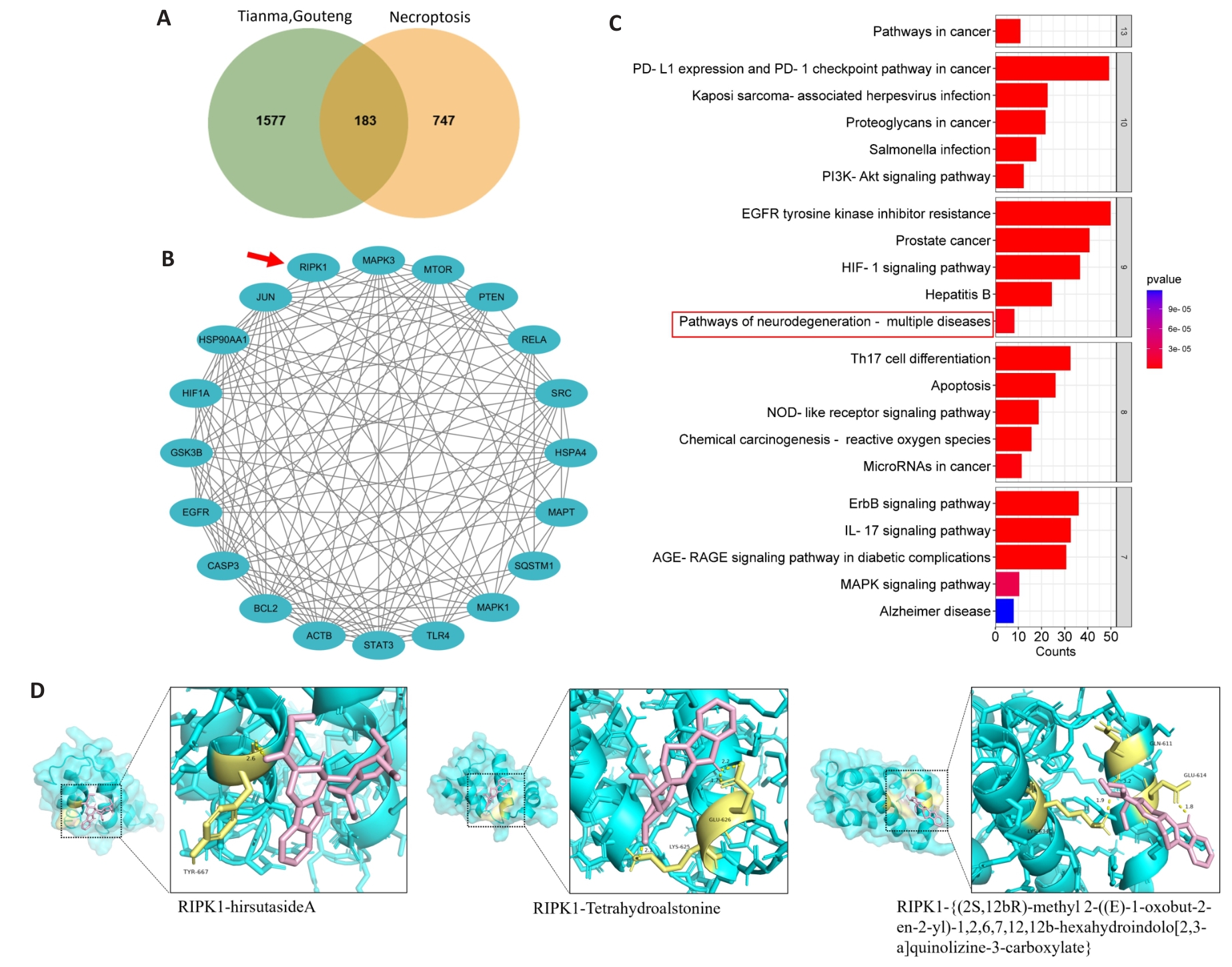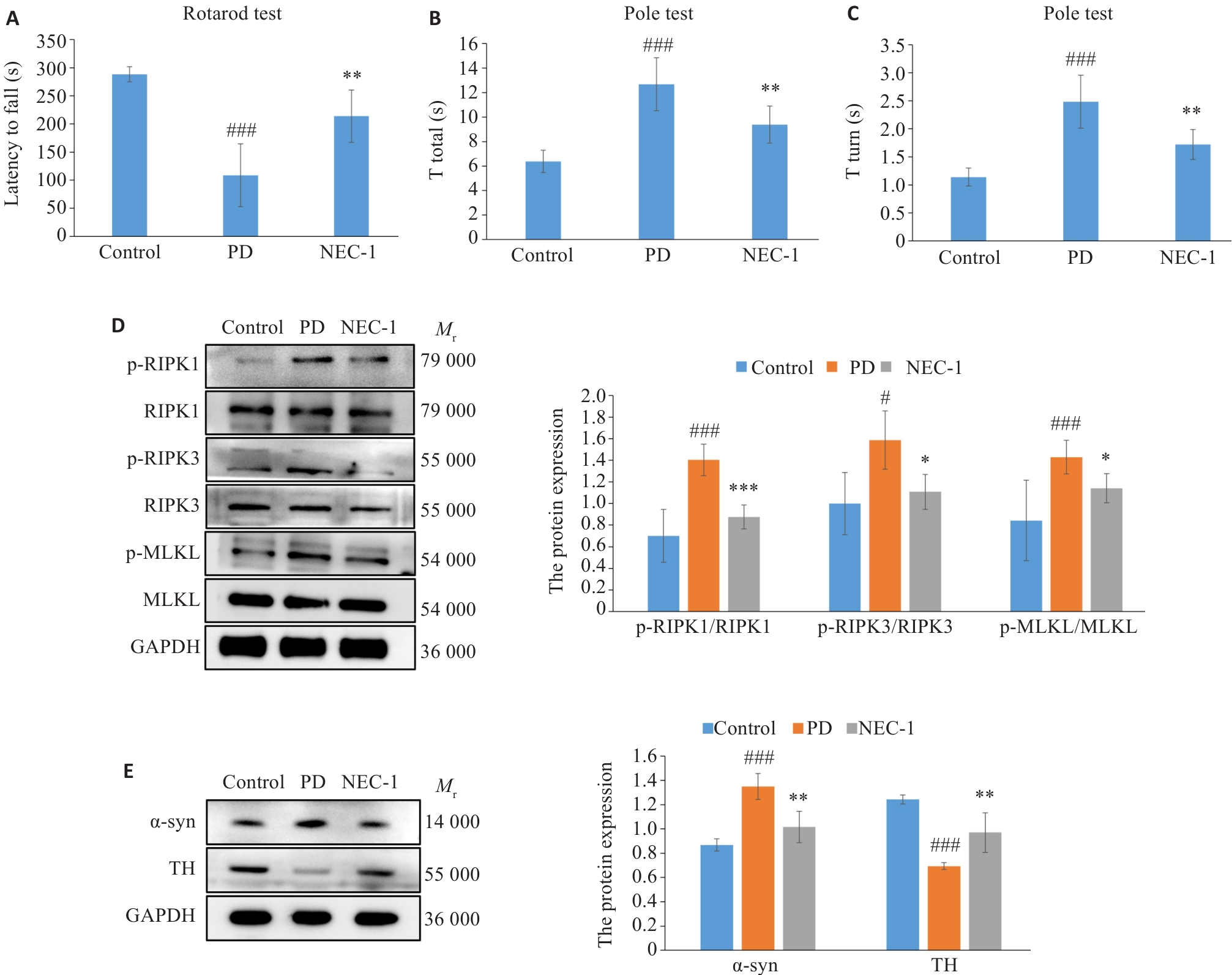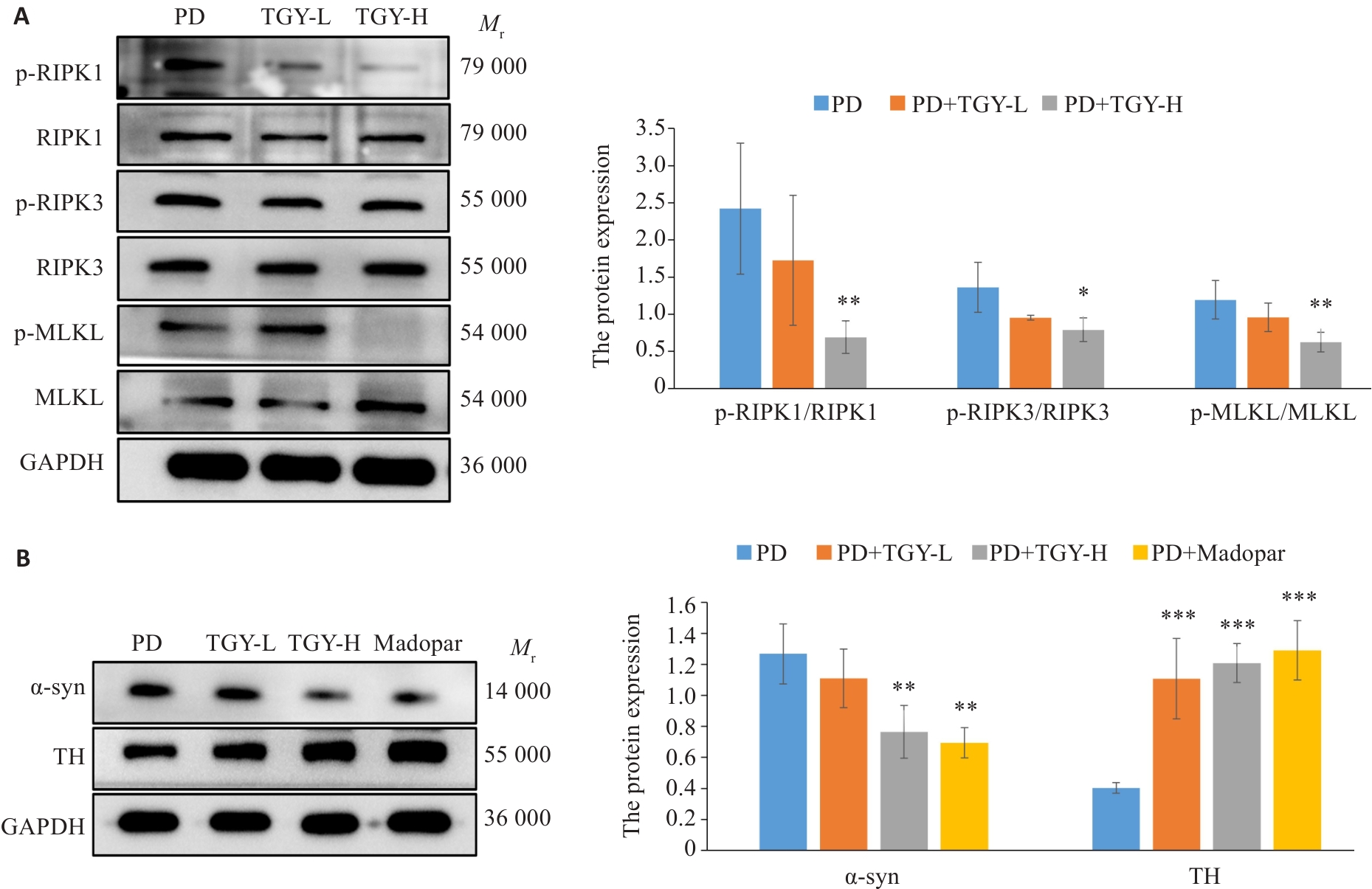Journal of Southern Medical University ›› 2025, Vol. 45 ›› Issue (8): 1571-1580.doi: 10.12122/j.issn.1673-4254.2025.08.01
Dandan CHEN1,3( ), Qianqian REN1, Menglin LÜ1, Baowen ZHANG1, Xingran LIU1,4, Meng ZHANG1, Yang WANG3, Xianjuan KOU1,2(
), Qianqian REN1, Menglin LÜ1, Baowen ZHANG1, Xingran LIU1,4, Meng ZHANG1, Yang WANG3, Xianjuan KOU1,2( )
)
Received:2025-03-27
Online:2025-08-20
Published:2025-09-05
Contact:
Xianjuan KOU
E-mail:1506087776@qq.com;kouxianjuan@126.com
Supported by:Dandan CHEN, Qianqian REN, Menglin LÜ, Baowen ZHANG, Xingran LIU, Meng ZHANG, Yang WANG, Xianjuan KOU. Tianma Gouteng Granule improves motor deficits in mouse models of Parkinson's disease by regulating the necroptosis pathway[J]. Journal of Southern Medical University, 2025, 45(8): 1571-1580.
Add to citation manager EndNote|Ris|BibTeX
URL: https://www.j-smu.com/EN/10.12122/j.issn.1673-4254.2025.08.01

Fig. 1 Establishment of mouse models of MPTP/p-induced Parkinson's disease (PD). A: Schematic diagram of mice tested on the runway. B: Gait pattern and stride length in the control group. C: Gait pattern and stride length in the PD model group. D: Quantification of step cycle. E: Quantification of stride length. F: Expression of TH protein and a-syn protein in the striatum of the mice. Data are presented as Mean±SD if not specified otherwise and analyzed using one-way ANOVA. ##P<0.01,###P<0.001 vs Control. LF: Left front paw. RF: Right front paw. LH: Left hind. RH: Right hind.

Fig.2 Tianma Gouteng Yin (TGY) at low (TGY-L) and high doses (TGY-H) improves motor deficits in PD mice by. A: Quantification of step cycle. B: Quantification of stride length. C: Quantification of latency to fall in rotarod test. D: Quantification of T-total in pole test. E: Quantification of T-turn in pole test. *P<0.05, **P<0.01, ***P<0.001 vs PD; ^P<0.01, ^^P<0.01, ^^^P<0.01 vs PD+TDY-L.

Fig.3 Prediction results of network pharmacology. A: TGY and necroptosis intersection genes. B: PPI network diagram of the core target proteins. C: Bubble map of KEGG analysis of the key genes. D: Molecular docking result patterns of RIPK1 and compounds in TGY.

Fig.4 NEC-1 attenuates motor deficits and pathological protein accumulation in PD mice. A: Quantification of latency to fall in rotarod test. B: Quantification of T-total in pole test. C: Quantification of T-turn in pole test. D: Expression of key proteins of the necroptosis pathway in the striatum of the mice. E: Expression of TH and a-syn protein in the striatum of the mice. #P<0.05, ###P<0.001 vs Control; *P<0.05, **P<0.01, ***P<0.001 vs PD.

Fig.5 TGY attenuates the necroptosis pathway and pathological protein accumulation in PD mice. A: Expression of the key proteins of the necroptosis pathway in the striatum of the mice. B: Expression of TH protein and a-syn protein in the striatum of the mice.*P<0.05, **P<0.01, ***P<0.001 vs PD.
| [1] | 王 刚, 徐 刚, 谢心怡, 等. 中国帕金森病报告2025[J]. 神经病学与神经康复学杂志, 2025, 21(2): 63-98. |
| [2] | Wu EP, He WY, Wu CL, et al. HSPA8 acts as an amyloidase to suppress necroptosis by inhibiting and reversing functional amyloid formation[J]. Cell Res, 2023, 33(11): 851-66. doi:10.1038/s41422-023-00859-3 |
| [3] | Roodveldt C, Bernardino L, Oztop-Cakmak O, et al. The immune system in Parkinson's disease: what we know so far[J]. Brain, 2024, 147(10): 3306-24. doi:10.1093/brain/awae177 |
| [4] | Zhou YQ, Xiang YX, Liu SJ, et al. RIPK3 signaling and its role in regulated cell death and diseases[J]. Cell Death Discov, 2024, 10(1): 200. doi:10.1038/s41420-024-01957-w |
| [5] | 童诗逸, 张 蒙, 盛科研, 等. 二氢杨梅素抑制坏死性凋亡信号通路改善帕金森病小鼠认知功能障碍的作用机制[J]. 中药新药与临床药理, 2023, 34(3): 296-302. doi:10.19378/j.issn.1003-9783.2023.03.002 |
| [6] | Cheng L, Huang ZY, He JW, et al. Exploring the effects of Tianma Gouteng granules on L-NAME-induced hypertensive rats based on 16S rDNA gene sequencing and metabolomics[J]. Heliyon, 2025, 11(2): e41786. doi:10.1016/j.heliyon.2025.e41786 |
| [7] | 秦 钦, 时拥月, 姚佳梅, 等. 天麻钩藤饮对自发性高血压大鼠p38 MAPK/HSP27通路影响的研究[J]. 北京中医药大学学报, 2023, 46(12): 1694-705. |
| [8] | Zhong M, Xu QQ, Hu Z, et al. Tianma-Gouteng pair ameliorates the cognitive deficits on two transgenic mouse models of Alzheimer's disease[J]. J Ethnopharmacol, 2024, 328: 118113. doi:10.1016/j.jep.2024.118113 |
| [9] | 李晓明, 荣 华, 潘思文, 等. 天麻素联合异钩藤碱通过线粒体途径抑制MPP+诱导PC12细胞凋亡[J]. 天然产物研究与开发, 2021, 33(7): 1096-101. doi:10.16333/j.1001-6880.2021.7.003 |
| [10] | Ali N, Syeda A, Topgyal T, et al. Parkinson's disease: a current perspectives on Parkinson's disease and key bioactive natural compounds as future potential drug candidates[J]. Curr Drug Targets, 2022, 23(1): 2-20. doi:10.2174/1389450122666210623115505 |
| [11] | 于 潇, 祝琳琳, 刘 婕, 等. 钩藤中单萜吲哚类生物碱成分及其药理活性的研究进展[J]. 中草药, 2021, 52(19): 6052-65. doi:10.7501/j.issn.0253-2670.2021.19.029 |
| [12] | 梁建庆, 何建成. 病证结合帕金森病小鼠模型的构建[J]. 中国老年学杂志, 2017, 37(20): 4961-3. doi:10.3969/j.issn.1005-9202.2017.20.003 |
| [13] | 张 蒙, 孟祎静, 聂碧徽, 等. 自噬-STING信号在跑台运动抑制细胞焦亡改善PD小鼠认知功能障碍中的机制研究[J]. 体育科学, 2024, 44(10): 58-76. |
| [14] | 朱仁艳, 王亚丽, 张英美, 等. 天麻钩藤饮及其单味药治疗帕金森病的研究进展[J]. 中国实验方剂学杂志, 2024, 30(3): 239-48. |
| [15] | Deng LH, Liu W, Xu Q, et al. Tianma Gouteng Decoction regulates oxidative stress and inflammation in AngII-induced hypertensive mice via transcription factor EB to exert anti-hypertension effect[J]. Biomed Pharmacother, 2022, 145: 112383. doi:10.1016/j.biopha.2021.112383 |
| [16] | 张彦彦, 李晶洁, 龙芸鸾, 等. 天麻钩藤饮防治神经系统疾病的研究进展[J]. 中成药, 2022, 44(9): 2901-5. doi:10.3969/j.issn.1001-1528.2022.09.027 |
| [17] | Zhou ZD, Saw WT, Ho PGH, et al. The role of tyrosine hydroxylase-dopamine pathway in Parkinson's disease pathogenesis[J]. Cell Mol Life Sci, 2022, 79(12): 599. doi:10.1007/s00018-022-04574-x |
| [18] | Gao J, Zhang WX, Chai XQ, et al. Asparagine endopeptidase deletion ameliorates cognitive impairments by inhibiting proinflammatory microglial activation in MPTP mouse model of Parkinson disease[J]. Brain Res Bull, 2022, 178: 120-30. doi:10.1016/j.brainresbull.2021.11.011 |
| [19] | Leem YH, Park JS, Park JE, et al. Suppression of neuroinflammation and α-synuclein oligomerization by rotarod walking exercise in subacute MPTP model of Parkinson's disease[J]. Neurochem Int, 2023, 165: 105519. doi:10.1016/j.neuint.2023.105519 |
| [20] | Lei T, Fu GS, Xue X, et al. Tianma Gouteng Decoction improve neuronal synaptic plasticity and oligodendrocyte apoptosis in Parkinson's disease mice[J]. Phytomedicine, 2025, 140: 156553. doi:10.1016/j.phymed.2025.156553 |
| [21] | Lu CC, Qu SH, Zhong ZF, et al. The effects of bioactive components from the rhizome of gastrodia elata blume (Tianma) on the characteristics of Parkinson's disease[J]. Front Pharmacol, 2022, 13: 963327. doi:10.3389/fphar.2022.963327 |
| [22] | 程 申, 郎旭东, 方 芳, 等. 天麻钩藤饮对抽动障碍模型大鼠行为改善及神经保护作用[J]. 中国现代应用药学, 2023, 40(11): 1475-80. doi:10.13748/j.cnki.issn1007-7693.20223791 |
| [23] | 王 鑫, 卢 旭, 劳家珩, 等. 天麻钩藤饮辅以针刺治疗肝阳上亢型成人抽动障碍的临床观察[J]. 中国实验方剂学杂志, 2022, 28(22): 137-42. |
| [24] | Jin MY, Cao B, Lin C, et al. Tianma Gouteng decoction exerts pregnancy-protective effects against preeclampsia via regulation of oxidative stress and NO signaling[J]. Front Pharmacol, 2022, 13: 849074. doi:10.3389/fphar.2022.849074 |
| [25] | Pasparakis M, Vandenabeele P. Necroptosis and its role in inflammation[J]. Nature, 2015, 517(7534): 311-20. doi:10.1038/nature14191 |
| [26] | Zhang T, Rui WJ, Sun Y, et al. Identification of nitric oxide-mediated necroptosis as the predominant death route in Parkinson’s disease[J]. Mol Biomed, 2024, 5(1): 44. doi:10.1186/s43556-024-00213-y |
| [27] | 张 蒙, 张源源, 牛梦竹, 等. 双氢杨梅素通过诱导自噬减轻慢性帕金森病小鼠的细胞焦亡和坏死性凋亡[J]. 南方医科大学学报, 2023, 43(8): 1268-78. |
| [28] | Iannielli A, Bido S, Folladori L, et al. Pharmacological inhibition of necroptosis protects from dopaminergic neuronal cell death in Parkinson's disease models[J]. Cell Rep, 2018, 22(8): 2066-79. doi:10.1016/j.celrep.2018.01.089 |
| [29] | Geng L, Gao WQ, Saiyin H, et al. MLKL deficiency alleviates neuroinflammation and motor deficits in the α-synuclein transgenic mouse model of Parkinson's disease[J]. Mol Neurodegener, 2023, 18(1): 94. doi:10.1186/s13024-023-00686-5 |
| [30] | Lin QS, Chen P, Wang WX, et al. RIP1/RIP3/MLKL mediates dopaminergic neuron necroptosis in a mouse model of Parkinson disease[J]. Lab Invest, 2020, 100(3): 503-11. doi:10.1038/s41374-019-0319-5 |
| [31] | Leem YH, Kim DY, Park JE, et al. Necrosulfonamide exerts neuroprotective effect by inhibiting necroptosis, neuroinflammation, and α-synuclein oligomerization in a subacute MPTP mouse model of Parkinson's disease[J]. Sci Rep, 2023, 13(1): 8783. doi:10.1038/s41598-023-35975-y |
| [32] | Park JS, Leem YH, Kim DY, et al. Neuroprotective and anti-inflammatory effects of the RIPK3 inhibitor GSK872 in an MPTP-induced mouse model of Parkinson's disease[J]. Neurochem Int, 2024, 181: 105896. doi:10.1016/j.neuint.2024.105896 |
| [33] | Cao LY, Mu W. Necrostatin-1 and necroptosis inhibition: pathophysiology and therapeutic implications[J]. Pharmacol Res, 2021, 163: 105297. doi:10.1016/j.phrs.2020.105297 |
| [34] | Wang R, Ren HG, Kaznacheyeva E, et al. Association of glial activation and α-synuclein pathology in Parkinson's disease[J]. Neurosci Bull, 2023, 39(3): 479-90. doi:10.1007/s12264-022-00957-z |
| [35] | 胡梦妮, 张小蕾, 荣 臻, 等. 基于PI3K/AKT信号通路探究天麻钩藤饮对MPTP诱导帕金森病小鼠的作用机制[J]. 中国老年学杂志, 2025, 45(2): 345-51. |
| [36] | Jiang YN, Guo YZ, Lu DH, et al. Tianma Gouteng granules decreases the susceptibility of Parkinson's disease by inhibiting ALOX15-mediated lipid peroxidation[J]. J Ethnopharmacol, 2020, 256: 112824. doi:10.1016/j.jep.2020.112824 |
| No related articles found! |
| Viewed | ||||||
|
Full text |
|
|||||
|
Abstract |
|
|||||